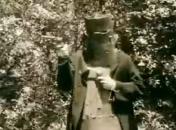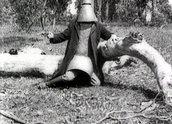AustLit
Latest Issues
AbstractHistoryArchive Description
'The picture is an exceedingly interesting one right from the opening scene, where Constable Fitzpatrick arrives with a warrant for the arrest of Dan Kelly, then to the police camp, which is captured by the Kellys, the sticking-up of Younghusband's station, robbing the bank at Euroa, destroying the railway line, and finally to the capture of Ned Kelly in his suit of armour.'
[Source: 'The Story of the Kelly Gang', The Register, 29 December 1906, p.4.]
Notes
-
At over an hour long, this Australian-made production is thought to be the world’s first feature-length narrative movie (Sally Jackson and Graham Shirley, 2006).
-
The Story of the Kelly Gang (1906) is inscribed on the UNESCO Australian Memory of the World Register.
Publication Details of Only Known VersionEarliest 2 Known Versions of
Works about this Work
-
The Story of the Kelly Gang 1906
i
"From a fallen tree, all",
2020
single work
poetry
— Appears in: In Your Hands 2020; (p. 89) -
Dead Heart : Australia’s Horror Cinema
2018
single work
column
— Appears in: FilmInk , 31 October 2018; -
Introduction : Screening Melbourne
2017
single work
essay
— Appears in: Senses of Cinema , December no. 85 2017; -
Lost Adaptations : Piracy, ‘Rip Offs’, and the Australian Copyright Act 1905
2017
single work
criticism
— Appears in: Historical Journal of Film, Radio and Television , vol. 37 no. 2 2017; (p. 161-173)'In this article, I want to historicise the study of Australian film adaptation by concentrating on the Copyright Act 1905, which during the nascent industrialisation of patent and copyright law did not recognise celluloid pictures as matter that could be copyrighted. Consequently, with the Act formed to provide authors greater powers to stop the proliferation of degraded versions of their work, film-makers saw adaptation as a strategy to legally protect their moving pictures from copyright infringements. By concentrating on Australia’s early industry of feature film production, it becomes apparent that through adaptation, and through the ability to copyright film as adaptation, there was a strong incentive in this formative period of Australian film production to adapt popular history tales drawn from the literature. And it was through this 1905 Act that the tradition of Australian adaptation and tradition of adapting historically set works began.
'While such an approach is necessary for this study, which concentrates on ‘lost’ feature films, the idea is to consider all forms and types of past and present adaptation as a way to encourage and advance its study. Here, I hope to gain some sort of understanding of how these literary works were being adapted, and socially consumed by its film-going audiences. This approach does not rely solely on a film’s source of adaptation or any one particular film. Instead, it places it within legal discourses of cinema activities including distribution, exhibition and marketing. By concentrating on the Australian cinema’s dedicated tradition of adaptation, during the silent period of film production, in this article, I will discuss how filmgoers at, and outside of, the cinema were encouraged to engage with feature films as adaptation – and what this culturally meant. In doing this, I hope to establish how Australian film adaptation began as a means to copyright a film from piracy and plagiarism ‘rip offs’.'
Source: Abstract.
-
The Story of the Kelly Gang Rewatched – The World's First Feature-length Film
2016
single work
review
— Appears in: The Guardian Australia , 6 March 2016;
— Review of The Story of the Kelly Gang 1906 single work film/TV
-
The Story of the Kelly Gang Rewatched – The World's First Feature-length Film
2016
single work
review
— Appears in: The Guardian Australia , 6 March 2016;
— Review of The Story of the Kelly Gang 1906 single work film/TV -
Ned's Stolen Moment in the Spotlight Completely Covered
2006
single work
column
— Appears in: The Canberra Times , 25 November 2006; -
Your Job is to Amaze Me
2011
single work
criticism
— Appears in: Griffith Review , [Autumn] no. 31 2011; -
More Australian than Aristotelian : The Australian Bushranger Film, 1904-1914
2002
single work
criticism
— Appears in: Senses of Cinema , January-February no. 18 2002;This analysis of The Story of the Kelly Gang, Thunderbolt, and The Squatter's Daughter considers early Australian films in the light of American cowboy films, arguing that 'it is the contention of this paper that these relations are the result of certain cultural coincidences between Australia and the Western United States rather than the outcome of direct influence of the one upon the other. Viewed in this light, “the American cinema par excellence” can perhaps be more reasonably understood as the epitome of a global cinema – not an original myth of nationhood, but a story of no-place retold everywhere and at all times, even in terra nullius itself.'
-
Marvellous Melbourne : Queen City of the South
2011
single work
criticism
— Appears in: Senses of Cinema , 23 June no. 59 2011; -
Poetry as Cinema : A Discursive Screening from 1913-2006
2011
single work
criticism
— Appears in: Southerly , vol. 71 no. 3 2011; (p. 135-148) 'Australian cinema began with a confident leap into the future. Charles Tait's The Story of the Kelly Gang, made in Melbourne in 1906, is credited as the world's first narrative feature. Post-Federation years continued to see poetry influence the national imagination, and occasionally inspire cinema on its journey.' (Author's abstract)





